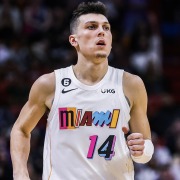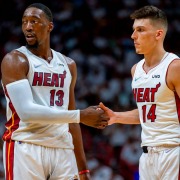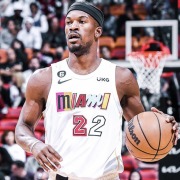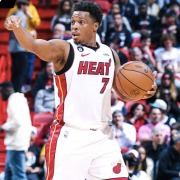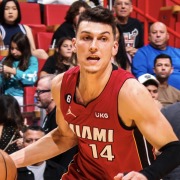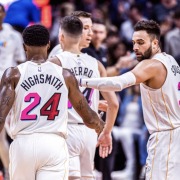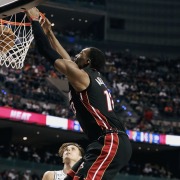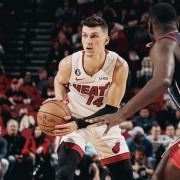Five Takeaways from Heat’s Win Over Jazz
The Miami Heat played on the second night of a back to back in Utah on New Years Eve, and pulled away with a win.
Victor Oladipo showcased elite two-way skills, Bam Adebayo scores 32 points, oh and Tyler Herro’s game winner.
Some takeaways from this one…
#1: Victor Oladipo’s early punch on both ends.
As the first quarter comes to a close, the Heat lacked energy. Lacked an identity. Victor Oladipo entered the game, and he provided just that. Heat ran an action that many fans are familiar with, Duncan Robinson slipping a screen initially to create space for the PnR between the ball handler and the big man. That ball-handler happened to be Oladipo. He bursted down the right slot for the tough lay-in. Off the make, he pressured full court, deflecting and stealing the ball leading to the eventual Max Strus lay-in. He followed all that up with a three-point flurry in the second quarter. Catch and shoot looks as the Herro-Oladipo combo just continues to impress.
#2: We know Tyler Herro the scorer. We know Tyler Herro the passer. But how about Tyler Herro out of set actions?
Final possession of the second quarter, as the ball is placed in the hands of Tyler Herro. The entire goal is to get a shot with ideally 0 seconds on the clock, as he tries to time it. They run a variation of Spain PnR, as it’s a Herro-Orlando pick and roll, with Strus rising to the left wing off a ghost screen. Herro takes that extra dribble and step to pressure the defense, then zips it to Strus for the buzzer beater three. I may have just described one single play, but we’ve seen it much more frequently than that. I often harp on the Herro-Bam PnR, which we saw a good amount of tonight, but the more complex actions with multiple things going on fits his style. Moving parts is key for him, since one of his biggest strengths is manipulating off-ball defenders. He knows now that he gets a ton of extra attention at this stage, but now he’s realizing how to truly use it to his advantage.
#3: It’s time to flush three-point reliance…Well, to an extent.
We often hear in post game conversations that the goal for this Heat team is to hit that 40 three bench mark. In a very new age of basketball, it’s almost necessary to keep up with many of these high powered offenses. But the way to get to that baseline needs to be the result of another priority. When I look at guys like Jimmy Butler, Adebayo, Oladipo, and even Herro, they are their best versions following a heavy rim attack diet. Not only does it get them into an individual rhythm, but it shrinks the floor just enough for shooters to follow. Watching Adebayo’s attack, Oladipo’s rim pressure, and Herro’s in-between floater and passing game tonight, it only furthers that point. This team has totally fallen off the map in the three-point region, while also recognizing it can return at any point. But relying on that resurgence will never be the answer. Strong drives, free throw attempts, and rim pressure is the true Miami Heat MVP.
#4: The Heat’s inconsistencies appearing in the third quarter yet again.
When talking about inconsistencies in that third quarter, I could sit here and talk about specific possessions like when Bam had Mike Conley on his back under the basket, and that play resulted in two contested three pointers from Kyle Lowry and Haywood Highsmith. Process is important, but the offense wasn’t the issue again tonight. Back to back nights, this team just couldn’t generate stops on the defensive end for large pockets of time. When looking at specifics, it really comes down to something Erik Spoelstra harped on a few weeks ago: containing the ball. That’s where it all begins. If this team doesn’t pressure that initial creator, you’re betting on weaker defenders in tougher rotations once that initial paint touch is made. It’s something that needs
#4: Late-game discussion: Adebayo, Oladipo, Herro lead way.
Victor Oladipo sits at the top of the key with Kelly Olynyk guarding him 1-on-1. A screen comes and a miscommunication follows, as Oladipo drifts down the lane into a massive and-1 dunk right at the rim over Walker Kessler. That was pretty much a needed spark. The Heat picked up on the defensive end, which began with Oladipo up at the top, as turnovers flowed in. A Herro fast-break 2 into an eventual Oladipo rip and Adebayo and-1 shot in his in-between range looked like Miami found themselves for a large stretch. Fast forward to a bit later with 3 minutes left in the game, the Heat are up by 5. Herro snakes inside after drawing 2, feeds it to Bam in that mid-post, who fires a face-up jumper over his defender to give Miami a 7 point lead. As you would expect, the Jazz cut into that lead a bit, forcing Miami to execute to perfection late. With a 4 point lead with 30 seconds left, it looked like the Heat would dribble it out as long as possible. Herro ended up taking a deep three with 9 seconds left on the shot clock, giving the Jazz a chance on the break. Fast forwarding to late-game, a terrible foul call gives Markannan three free throws to tie. As Herro answers with the game winning three point floater. Happy New Year.
